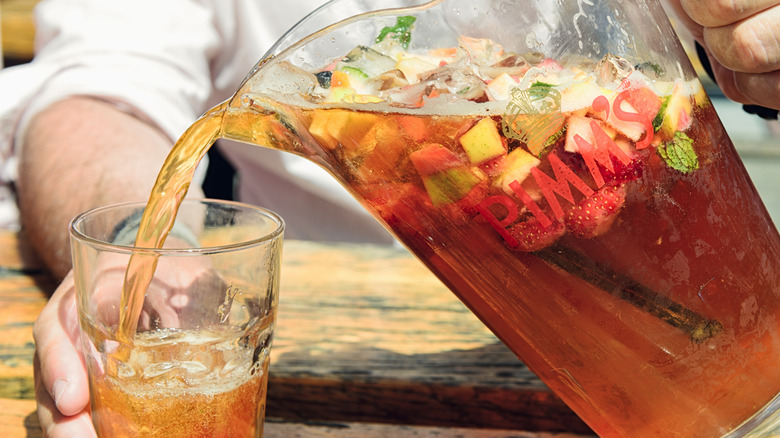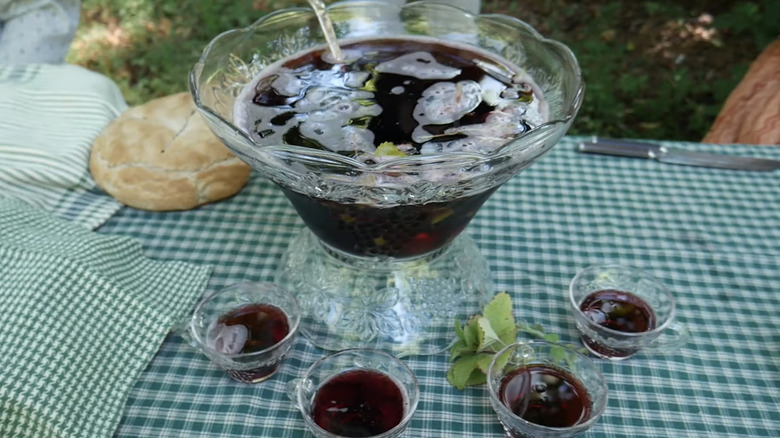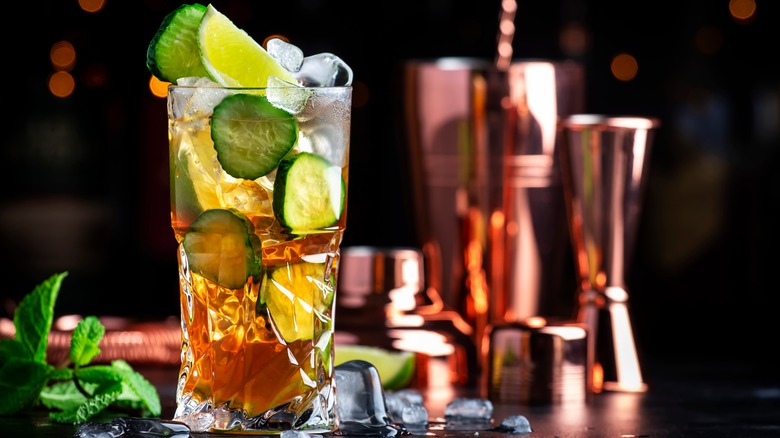Claret Vs Pimm's Cup: What's The Difference Between These Cocktails?
While the British are known for loving a good drink, Americans mostly associate their tastes with pints of ale and botanical gin. But British drinking culture goes far beyond lukewarm beer — in fact, it's responsible for some pretty phenomenal cocktail recipes. In recent years, the everything-but-the-kitchen-sink cocktail called the Pimm's Cup has become popular beyond the Atlantic island, but one of its contemporaries, the Claret Cup, hasn't received the same reception. This is a shame, as it's an equally delicious drink.
The Claret Cup and the Pimm's Cup were both created sometime in the 19th century, though some mistakenly refer to Claret as Pimm's predecessor — think of Claret not as Pimm's great-grandfather but as more of a cousin. Both beverages are meant to be refreshing summer cocktails, often enjoyed during cookouts that turn into all-nighters. The two are very different, however, despite both being sweet drinks often served alongside fresh-cut fruit, vegetables, and herbs. Even if they're often compared, don't order one thinking it'll taste like the other — a Claret Cup uses a wine base, while a Pimm's Cup is made from gin.
The Claret Cup is a sweet, sparkling batch cocktail
Classic Claret Cup recipes, like any vintage cocktail, come with plenty of variation, but all Claret Cups feature red wine as their main base. Claret is a British term used to refer to Bourdeaux wine blends, usually merlot and cabernet sauvignon, but in the Cup's case, you can use any number of wines, including Beaujolais and syrah.
Tracking down the very first iteration of the Claret Cup is difficult, but just within the 1873 book "The Gentleman's Table Guide," several variations of the cocktail appear. In each, red wine is mixed with several ingredients, almost always including lemon, sugar, carbonated water, and an assortment of fruit and berries. This might sound like an odd combination, but it's quite similar to Sangria's slightly lazier sibling, Tinto de Verano. Jammy red wines shine with a bit of extra acidity, carbonation, and sweetness. Traditionally, the Claret Cup was served as a batch cocktail or punch.
Recipes sometimes call for the addition of either brandy, cognac, triple sec, curacao, or sherry, so you can use whatever suits your preference. Older recipes for the Claret Cup suggest sweetening the drink with powdered sugar, likely because it dissolves quickly, but a simple syrup will also work. Just stir the ingredients with ice until the drink is well-chilled, then garnish with fresh berries, citrus slices, cucumber, mint, or whatever else you have on hand.
The Pimm's Cup is made from gin and often lemonade
The biggest difference between Pimm's and Claret Cups is that Pimm's is a gin-based beverage. Invented by James Pimm sometime in the early to mid-1800s, the first version of the drink consisted of gin, quinine (most likely the bark of a quinine plant), and herbs and was meant to aid digestion, as alcohol was often used medicinally at the time. It was first called the House Cup, then Pimm's No. 1 Cup. Just like the Claret Cup, Pimm's underwent several transformations, and the Pimm's Cup cocktail recipe people know today is very different from its predecessors.
Today, when folks reference a Pimm's Cup, they're most likely referring to a Pimm's and lemonade. This drink requires the pre-bottled Pimm's No. 1 mix, which is essentially an infused, gin-based liqueur that carries over many flavors from the first Pimm's drink. This mix is then combined with sparkling lemonade or lemonade and carbonated water, as well as a salad's worth of fresh produce. A Pimm's Cup is almost always served with slices of cucumber, strawberry, lemons, oranges, and bunches of fresh mint. It's these garnishes (verging on a side dish) that really separate a Pimm's from other cocktails, but it certainly shares similarities with the Claret Cup.


